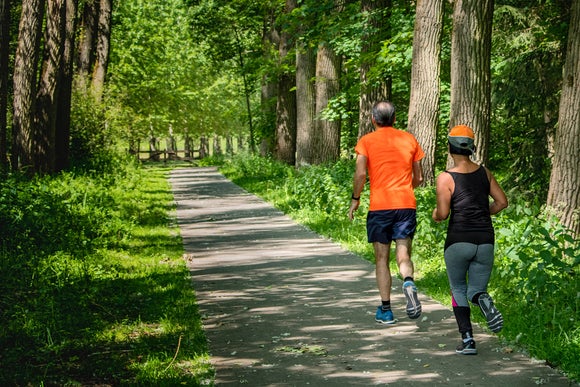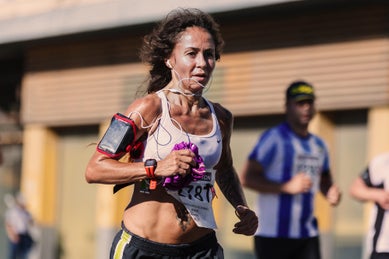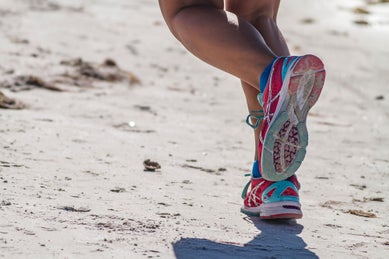Coach's Corner With Scott Douglas: Tips on Top Performance in Your 40s, 50s, and Beyond
Regardless of your level of experience, there are common elements that all older runners should include in their training program to avoid well-known pitfalls and keep running as you age.

Don't Get Injured
First and foremost, prioritising your health and avoiding injury is imperative for runners in their 30s, 40s, or older. No one can entirely prevent injuries from occurring, and no runner ever wants to be injured, but what can be a minor setback for someone in their 20s can mean the end of an entire season for someone in their 30s or 40s. This is because the body's repair processes slow as we age, which means little aggravations can stay around for weeks, and minor strains can develop into major problems if not cared for properly. To help avoid injury from occurring, runners should keep these tips in mind:
- Make your easy running days easy. Younger runners can get away with going too fast on days between hard training sessions, while older runners greatly increase their likelihood of injury if they are continuously pushing a hard pace. On an easy day, runners should feel as if they are storing up their energy versus slowly depleting it, and accessories like a heart rate monitor can help runners remain at a slow enough pace to avoid muscle deterioration (less than 70% of your max heart rate).
- With age, we lose muscle mass and the elasticity of our connective tissues slowly deteriorates. That is further exacerbated by the fact that many adults spend the bulk of their time driving to and from work or sitting at a desk, thus rarely moving outside of a small range of motion in their daily routines. For your weakest and tightest spots, pick a few exercises to do a couple of times a week so that your body can function more like it did in your mid-20s. Yoga, core strengthing, and weight training are great for all runners.
- Wear the right shoes. Similar to not training intelligently, younger runners can get away with being in the wrong shoes without necessarily getting injured. Older runners need to be sure that their shoes match their gait and biomechanical needs to minimise compensatory injuries. See more info on shoe selection and gait analysis to help find the right shoes for you.
Always Stay In Touch with Your Speed

As mentioned above, everyone loses muscle mass with age, as well as our body's fast-twitch muscle fibers, which help us produce more explosive power. If you want to do more than shuffle for the rest of your running career, then it is important to emphasise speed training as you age. A quick and easy way to incorporate speed into your training program is by doing strides at least twice a week. Even if you never intend to race again, make sure to include relaxed yet fast efforts of about 100 meters at the end of at least two easy runs each week. Don't strain yourself; instead, think about moving quickly across the ground while concentrating on maintaining good running form. Do 6 to 8 striders, all on a flat, level surface.
Maximum heart rate also declines with age, but that decline can be greatly slowed if you regularly train near your maximum. Also, doing this doesn't necessarily mean weekly gut-busting track sessions, but rather, when you're on a run and feeling strong, finish up the last 5 to 10 minutes at a pace that you could maintain for 30 to 60 minutes. In other words, finish your run at what I like to call a "comfortably fast" pace. Finally, run hills and perform drills. One aspect of maintaining your speed is preserving good running mechanics. Incorporating short hill repeats into your training a few times a month will help your stride length, muscular strength, as well as your ankle flexibility. Doing drills once or twice a week that emphasise aspects of good running form, such as high knees, fast feet, and lunges, will also keep your stride more open and smooth flowing. For more on hills and drills, see our article on How to Train Like a Kenyan.
Mind Your Weight

If you were at a healthy weight in your mid-20s, there's no real reason why you cannot maintain that weight later in life. Because our metabolism slows as we age, the number of calories we consume versus the amount we burn becomes a much more relevant equation. Runners should concentrate on eating nutrient-dense foods, because unlike when we are in our 20s, every calorie needs to count as an older athlete looking to maintain a healthy weight. The right food choices will also help you recover quicker from training, which we've already shown can be an issue for older runners.
If you can't run enough to maintain your weight without risking injury, add other forms of exercise to your training program. Cycling, water aerobics, cross-country skiing, or using an elliptical trainer are all excellent ways to burn calories without the harmful pounding of running. Although crosstraining might not directly improve your running performance, it will help you maintain a high degree of cardiovascular fitness that might not otherwise be possible through running alone.


